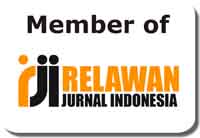Readability of Articles in Journal of Religious and Socio-cultural Studies
Abstract
Keywords
Full Text:
PDFReferences
Aksnes, D. W., & Sivertsen, G. (2019). A criteria-based assessment of the coverage of scopus and web of science. Journal of Data and Information Science, 4(1), 1–21. https://doi.org/10.2478/jdis-2019-0001
Biddinika, M. K., Lestari, R. P., Indrawan, B., Yoshikawa, K., Tokimatsu, K., & Takahashi, F. (2016). Measuring the readability of Indonesian biomass websites: The ease of understanding biomass energy information on websites in the Indonesian language. In Renewable and Sustainable Energy Reviews (Vol. 59, pp. 1349–1357). Elsevier Ltd. https://doi.org/10.1016/j.rser.2016.01.078
Buela-Casal, G., Zych, I., Medina, A., Viedma Del Jesus, M. I., Lozano, S., & Torres, G. (2009). Analysis of the influence of the two types of the journal articles; theoretical and empirical on the impact factor of a journal. Scientometrics, 80(1), 265–282. https://doi.org/10.1007/s11192-008-1715-6
Cha, M., Gwon, Y., & Kung, H. T. (2017). Language modeling by clustering with word embeddings for text readability assessment. International Conference on Information and Knowledge Management, Proceedings, Part F131841, 2003–2006. https://doi.org/10.1145/3132847.3133104
Daraz, L., Morrow, A. S., Ponce, O. J., Farah, W., Katabi, A., Majzoub, A., Seisa, M. O., Benkhadra, R., Alsawas, M., Larry, P., & Murad, M. H. (2018). Readability of Online Health Information: A Meta-Narrative Systematic Review. American Journal of Medical Quality, 33(5), 487–492. https://doi.org/10.1177/1062860617751639
Dolnicar, S., & Chapple, A. (2015). The Readability of Articles in Tourism Journals. Annals of Tourism Research, 52, 161–179.
DuBay, W. H. (2004). The Principle of Readability. Impact Information.
Elsevier. (2021). Discover the Target Audience of Your Research Paper. Elsevier. https://doi.org/https://scientific-publishing.webshop.elsevier.com/research-process/discover-target-audience-research-paper/
Graefe, A., Haim, M., Haarmann, B., & Brosius, H. B. (2018). Readers’ perception of computer-generated news: Credibility, expertise, and readability. Journalism, 19(5), 595–610. https://doi.org/10.1177/1464884916641269
Kher, A., Johnson, S., & Griffith, R. (2017). Readability Assessment of Online Patient Education Material on Congestive Heart Failure. Advances in Preventive Medicine, 2017, 1–8. https://doi.org/10.1155/2017/9780317
M. Coleman and T. L. Liau. (1975). A computer readability formula designed for machine scoring. Journal of Applied Psychology, 60(2), 283–284.
MacLean, S. A., Basch, C. H., Ethan, D., & Garcia, P. (2019). Readability of online information about HPV Immunization. Human Vaccines and Immunotherapeutics, 15(7–8), 1505–1507. https://doi.org/10.1080/21645515.2018.1502518
McCannon, B. C. (2019). Readability and research impact. Economics Letters, 180, 76–79. https://doi.org/10.1016/j.econlet.2019.02.017
McLaughlin, G. H. (1969). SMOG Grading: A New Readability Formula. Journal of Reading, 12(8), 639–646.
Moed, H. F., De Moya-Anegon, F., Guerrero-Bote, V., & Lopez-Illescas, C. (2020). Are nationally oriented journals indexed in Scopus becoming more international? The effect of publication language and access modality. Journal of Informetrics, 14(2), 101011. https://doi.org/10.1016/j.joi.2020.101011
Richards, J. ., & Schmidt Richard. (2002). Longman Dictionary of Language Teaching & Applied (Third). Person Education.
Rosita, N. (2018). Accuracy, Clarity, and Readability (ACR) in Historical Romance Novel Translation. Humanus, 17(1), 109. https://doi.org/10.24036/humanus.v17i1.9137
Salihah, P. R., Sahruddin, & Degeng, P. D. D. (2020). Text Readability in 11 th and 12 th Grade English Textbook of Indonesian Senior High School Published by Intan Pariwara with FKGL Formula. Diglossia: Jurnal Kajian Ilmiah Kebahasaan Dan Kesusastraan, 12(1), 11–19.
Savitri, Y. (2018). An Analysis of Students’ Translation Quality (Accuracy, Readability and Acceptability) in Translating an Informative Text Entitled Yseali to Indonesian (A Script). Universitas Lampung.
Sedghi, S., & Heshajin, S. G. (2018). Assessing of Iranian medical English journals based on journal selection criteria in Scopus. Library Philosophy and Practice, 2018(October).
Severance, S., & Cohen, K. B. (2015). Measuring the readability of medical research journal abstracts. 127–133.
Tenopir, C., Mays, R., & Wu, L. (2011). Journal article growth and reading patterns. New Review of Information Networking, 16(1), 4–22. https://doi.org/10.1080/13614576.2011.566796
Vajjala, S., & Luči´c, I. L. (2018). OneStopEnglish corpus: A new corpus for automatic readability assessment and text simplification.
Xia, M., Kochmar, E., & Briscoe, T. (2016). Text Readability Assessment for Second Language Learners. The 11th Workshop on Innovative Use of NLP for Building Educational Applications, 12–22.
Yulianto. (2019). An Analysis on Readability Level of English Reading Texts for Eighth Grade Students. J-SHMIC Journal of English for Academic, 6, No 1, 82–83.
Yuwono, D. (2015). Translation Quality of Translated Abstracts from Indonesian to English in The Journal of STAIN Ponorogo 2015. Jurnal Bahasa Dan Sastra, 2(2), 18–19.
DOI: http://dx.doi.org/10.31332/lkw.v7i1.2218
Copyright (c) 2021 Ai Yeni Yuliyanti, Busro Busro

This work is licensed under a Creative Commons Attribution-ShareAlike 4.0 International License.
Langkawi: Journal of The Association for Arabic and English indexed by:


















.png)
.png)

.png)
2.png)








